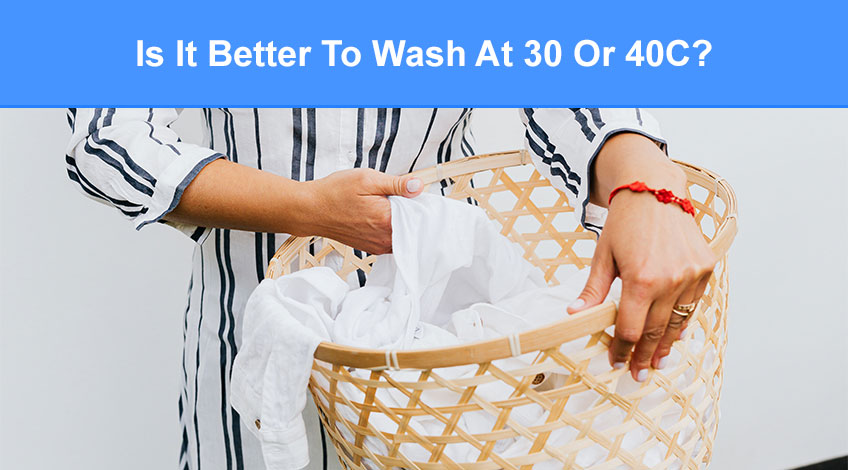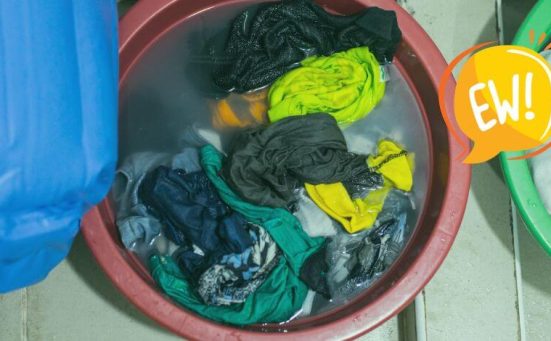
Is It Better To Wash At 30 Or 40C? (with examples)
With so many wash programmes on modern washing machines, deciding which setting to use can be difficult. Even more confusing still is trying to decide which temperature to wash your clothes at. Which leads to the question, is it better to wash clothes at 30 degrees or 40 degrees?
If getting the right water temperature to wash your clothes is causing you confusion, keep reading.
Why Is It So Important to Wash Clothes At The Right Temperature?
Selecting the correct temperature to wash your clothes is absolutely essential nowadays. Using the wrong temperature to wash your clothes can lead to damaged, shrunken clothes and colour fades.
Decent clothes aren’t cheap, which means we need to look after our clothes and that starts in the wash. This makes it vitally important to get the temperature right when washing your clothes. Which is why you need to understand the difference between washing clothes at 30 and 40 degrees.

Washing Clothes At 30 Degrees C
We’re all being told to reduce our carbon footprint and a good way to do this is to reduce the temperature of the water we use to wash our clothes. But is a 30 degree wash cycle good for our clothes?
The Benefits
The main benefits of washing your laundry at 30 degrees C include;
- Saves Energy
Switching from a 40 degree wash to a 30 degree wash can reduce energy usage by up to 40%. - Environmentally Friendly
The less energy you use the better it is for the environment. Added to which a 30 degree wash causes less harmful microplastics to be released into the water from synthetic materials. - Prolongs The Life Of Your Clothes
Clothes washed at 30 degrees will last longer because the lower temperature is gentler on the fabrics. - Prevents Colour Fade
Dark and coloured clothes are less likely to run or fade at 30 degrees. - Reduces The Risk Of Shrinkage
Many clothes can shrink in even warm water. The fibres contract which causes shrinkage in the material. This can still happen at 30 degrees but is far less likely. Clothes made from wool or silk for example are less prone to shrinking at 30 degrees than at 40 degrees as long as the correct wash cycle is selected.
The Downfalls
There are a few disadvantages to using a 30 degree wash cycle which include;
- Doesn’t Clean Heavily Soiled Garments
If you wash clothes that are heavily soiled a 30 degree wash will not remove all of the mess or kill all of the germs and bacteria. You will need to pretreat or pre-soak the clothes before washing to remove soaked in stains. - Doesn’t Remove All Bacteria & Germs
Many bacteria and germs can survive at 30 degrees C. To remove them at 30 degrees you will need to use a laundry sanitiser as well as a temperature specific detergent. - Not Suitable For Towels Or Bedding
To remove all of the germs and bacteria from towels and bedding you need to wash them at a temperature higher than 30 degrees. It is recommended that bedding and coloured towels are washed at 40 degrees and white towels should be washed at 60 degrees. - Doesn’t Remove Ingrained Dirt
Stains that have become ingrained will not be removed at 30 degrees. These will need pretreatment or pre-soaking before washing to loosen the dirt enough for the water at 30 degrees to clean.
Washing Clothes At 40 Degrees C
The next setting up from the 30 degree wash is the 40 degree wash. Washing clothes at 40 degrees will cost more money as the machine uses extra electricity to heat the water to 40 degrees. But are there any other disadvantages?
The Benefits Of Using The 40 Degree Wash
Let’s start by looking at the benefits which include;
- Saves Energy (compared to 60 degree wash)
Obviously, a 40 degree wash will use more energy than a 30 degree wash. But a 40 degree wash uses 77% less energy than a 60 degree wash, while still being quite warm. - Kills More Germs & Bacteria (compared to a 30 degree wash)
There are many germs and bacteria that cannot survive at 40 degrees C. Especially if you use the correct detergent to ensure that all germs are washed away. - Suitable For Bedding & Towels
Bedding and towels can safely be washed at 40 degrees, even coloured towels are safe to wash at 40 degrees. - Cleans Stains Easier
The hotter water loosens many stains without the need of any pretreatment or pre-soak.
The Disadvantages Of Using The 40 Degree Wash
The disadvantages of washing your laundry at 40 degrees includes;
- Clothes Will Not Last As Long
Washing clothes at higher temperatures can cause the fabrics to wear out quicker. - Some Materials Will Shrink
40 degrees is hot enough to cause the fibres of some fabrics to contract which makes the garment shrink. - Uses More Energy
Switching from 30 to 40 degrees will increase the amount of energy used to heat the water. - Costs More
This increase in energy usage will cost you more money. - Not As Environmentally Friendly
Using more energy does have an environmental impact as well.

What Should Be Washed At 30 Degrees C?
Washing clothes at 30 degrees does have many benefits but it is only really suitable for certain types of clothes. These include;
- Woollens
It is OK to wash woollen clothes at 30 degrees as long as you select the woollen cycle which is specifically designed to wash woollen clothes without damaging them. - Silks
Likewise, silk clothes should be washed at 30 degrees using the silk cycle. - Delicates
Delicates like acrylic, rayon etc should be washed at 30 degrees using the delicate cycle. - Clothes That Are not Heavily Soiled
Washing clothes at 30 degrees will only result in them becoming clean if they were not too dirty to begin with. - Clothes That Are Not Colour Fast
Washing coloured clothes at 30 degrees will help prevent the colours from running and fading.
What Should Be Washed At 40 Degrees C?
You should select the 40 degree temperature setting for the following types of clothes;
- Cotton Clothes
A 40 degree wash is perfect for washing cotton clothes, it’s hot enough to remove dirt and stains but not so hot that it will cause the cotton fibres to contract. - Coloured Towels
It is recommended that white towels are washed at 60 degrees but coloured towels should be washed at 40 degrees. - Bedding
40 degrees is perfect for cleaning bedding as long as you use a laundry sanitiser in with the wash. - Pet Bedding
Pet bedding is often made from synthetic materials which cannot withstand extremely high temperatures. 40 degrees is perfect for cleaning synthetic pet bedding. - Denim (inc. jeans)
We often think of denim being a tough fabric and in many ways it is. However, denim is likely to shrink at any temperature above 40 degrees C. - Sportswear & Gym Wear
Sports clothes and gym clothes are worn when we work out. This means they are subjected to sweat. As many sports clothes are made from man made materials, they do not absorb much moisture which makes a 40 degree wash perfect. - Most Synthetics
Many synthetic materials are made from a form of plastic which can shed harmful microplastics into the wash. These microplastics then get into our waterways and harm aquatic life. At 40 degrees, synthetics are likely to shed less microplastics than at hotter temperatures.
How To Adjust The Temperature On Your Washing Machine
Many wash programmes can be selected with the option to alter the wash temperature. But there are a few things you’ll need to check first. These include;
The Clothes You’re Washing
You should always consult the wash care label before selecting the water temperature to ensure the fabric can stand that particular level of heat. The wash care label will have a symbol of a bucket with water in it with a number.

That number is the temperature that the fabric should be washed at. For instance, the bucket with water and a number 30 indicates that the garment should be washed at 30 degrees. If the number was 40 it would mean a 40 degree wash and so on.
The Washing Machine’s Functionality
Check in your washing machine’s user manual to make sure you are clear on how to alter the wash temperature. On some machines you can simply select the temperature by pressing a button.
On others you can turn a dial and select an exact temperature setting.
How To Save Money When Doing Laundry
The best way to save on money when doing the washing is to use the lowest temperature for washing as you can. On average a 30 degree wash cycle uses around 40% less electricity than a 40 degree wash.
To keep washing clothes at 30 can require a few changes to your normal washing regime.
For instance, you may have to soak clothes or pretreat them to remove stubborn ingrained stains. This will ensure you only need to wash the clothes once at the lower temperature.
It’s also a good idea to use a laundry sanitiser at lower temperatures as well to ensure you remove all germs and harmful bacteria.
30 Or 40 Degrees; Which Is Best?
The truth is, there is no right or wrong way to wash many clothes. As long as you stick to the wash care guidelines, your clothes should get clean and germ free at whichever temperature you choose.
With that said, a 40 degree wash is more likely to remove many more stains than a 30 degree wash. However, detergents are becoming much better for use at lower temperatures.
There’s the financial incentive to washing at 30 which does equal a quite significant saving, but then there’s the extra cost of adding a laundry sanitiser to consider.
Your clothes will definitely last longer if you wash them at 30 degrees rather than 40. But many people get bored of the same old clothes anyway.
At the end of the day, it’s all about personal choice, if you’re prepared to put in the extra work of pretreating clothes, and adding a laundry sanitiser, then a 30 degree wash could be best for you.
On the other hand, a 40 degree wash will remove many more stains and bacteria without resorting to extra steps.
SEE ALSO: What Temperature Is A Cold Wash?
Frequently Asked Questions
Washing your clothes at 30 degrees will save a significant amount of money as it uses far less energy. However, the extra cleaning power of a 40 degree wash does mean clothes get cleaned better at 40 degrees.
There are certain delicate fabrics which are less likely to become damaged if washed at 30 degrees rather than 40 degrees. Wool, silk and many delicate fabrics are less prone to shrinkage or damage at 30 degrees. However, washing clothes at 40 degrees does clean them better.
A 40 degree wash is considered to be a warm wash. But it is too hot for some delicate fabrics which could shrink if washed at 40 degrees. You should always consult the wash care label before washing your clothes.
Also, follow us on Pinterest ...



